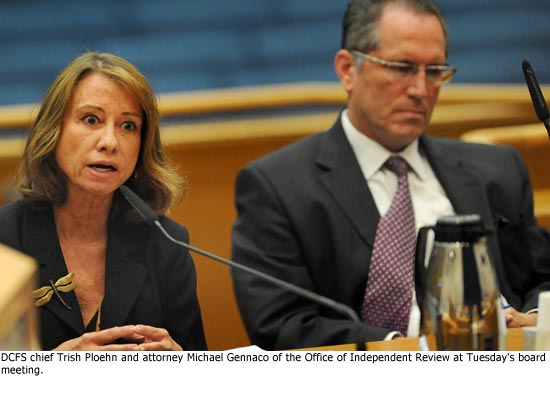Secret child-death records to be revealed
August 31, 2010
Los Angeles County’s top child welfare official—confronted with contradictions in her agency’s own records—vowed Tuesday to make public the deaths of dozens of children who’d been abused or neglected but whose cases had been questionably kept secret.
That pledge from Trish Ploehn, director of the Department of Children and Family Services, came on the heels of an independent study that raised new concerns about the agency’s compliance with a 2008 state law requiring the disclosure of child deaths that result from abuse or neglect.
The report, written by the county’s Office of Independent Review, said DCFS’ actions had effectively “frustrated” the law’s goal of preventing future tragedies by enhancing public scrutiny and promoting a more informed debate from which sound policy can flow.
For a third straight week, the issue of public access to child-death documents dominated the Board of Supervisors meeting—this time with less rancor but with a slew of new questions that have turned up the heat on Ploehn, who has spent the better part of a year defending her department and its stewardship.
On Tuesday, during her testimony before the board, Ploehn managed to diffuse some of the latest criticism by quickly making it clear that she agreed “100 percent” with at least one of the more troubling findings in the Office of Independent Review report.
The report disclosed that DCFS, in confidential dependency court documents, had classified upwards of 60 child deaths as resulting directly from neglect and abuse. But when it came to complying with a state law known as SB 39, DCFS exempted many, if not all, of those cases from public disclosure by concluding that they were not directly caused by abuse or neglect.
Ploehn blamed a lack of communication—and a difference in missions—between the two branches of her office responsible for the conflicting findings.
The dependency court filings, she said, relied on a broadly worded statute used to immediately remove at-risk siblings from homes where children had died and where there’d been evidence of abuse or neglect. The SB 39 cases, she said, required a much narrower finding that the death of a child was caused specifically by abuse or neglect.
“There was no communication or consultation going on between these two entities,” Ploehn told the board. “Therefore, we were in parallel universes.” She said every case in which DCFS had invoked the most serious claims of abuse or neglect in court filings would now be reclassified as a public document under SB 39 “and we will release those records.”
Michael Gennaco, who heads the Office of Independent Review, said he found no evidence of a concerted effort by DCFS to conceal child death cases. During the review, the OIR “received no information to believe that this alleged inconsistent approach in assessing child fatalities between different components of DCFS was either intentional or designed,” Gennaco wrote in his report and repeated during his Tuesday testimony before the board.
That statement, however, brought a quick word of caution from Supervisor Zev Yaroslavsky.
“I don’t think you have all the information that you’re going to have going forward,” Yaroslavsky warned Gennaco, adding: “There are reasons to believe this is not just an accidental disconnect, [that] the left hand didn’t know what the right hand was doing.”
Last week, Yaroslavsky raised the possibility that DCFS may be failing to comply with the public disclosure requirements of SB 39 to shield itself from criticism. Specifically, he pointed to the case of an 11-year-old boy who had hung himself in June after years of physical abuse. That case, Yaroslavsky said, had not been publicly disclosed, even though the boy’s suicide seemed to be the direct result of the abuse he suffered.
On Tuesday, under questioning from Yaroslavsky, Gennaco acknowledged that the boy’s death was one of the anonymous examples in his report, one in which DCFS had cited abuse as the cause of death in court documents but made no similar finding under SB 39.
“The issue for me is whether…the public is getting complete and accurate information about child deaths, which was the purpose behind SB 39 in the first place in 2008,” said Yaroslavsky, who praised a series of recommendations Gennaco offered to bring more clarity and continuity to DCFS’ procedures. “I raised it last week and I was right.”
In his report, Gennaco said that DCFS’ public disclosure of child-death cases also had dropped dramatically in the past two years because of “blanket law enforcement objections to the release of information.” He blamed this on DCFS’ failure to give law enforcement officials copies of the files to determine what information might—or might not—jeopardize an ongoing criminal case. In the absence of such details, Gennaco said, it’s understandable that law enforcement agencies would opt to keep the entire case confidential.
“It is apparent that that the stream of information about SB 39 child deaths that was flowing in 2008, has been largely shut down two years later as a result of law enforcement’s blanket holds,” Gennaco wrote.
So many Los Angeles County cases are being excluded from public disclosure in this way under SB 39, Gennaco said, that there’s “a virtual paralysis of the statute’s intent.”
He suggested that DCFS immediately begin providing more information to law enforcement agencies before decisions are made about public disclosure and that continuous reviews are made of case files to determine when additional information can be released.
Overall, Gennaco concluded, DCFS must develop a mindset and procedures that recognize the intent of the state law is to provide more, rather than less, information to the public and thus “ensure that there is a consistent and principled determination of what constitutes SB 39 cases subject to disclosure.”
Posted 8/31/10













 405 bridge work causes a stink
405 bridge work causes a stink

